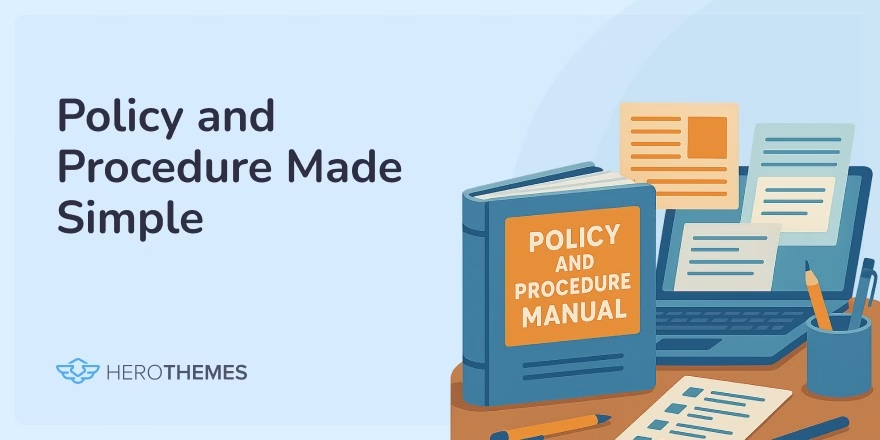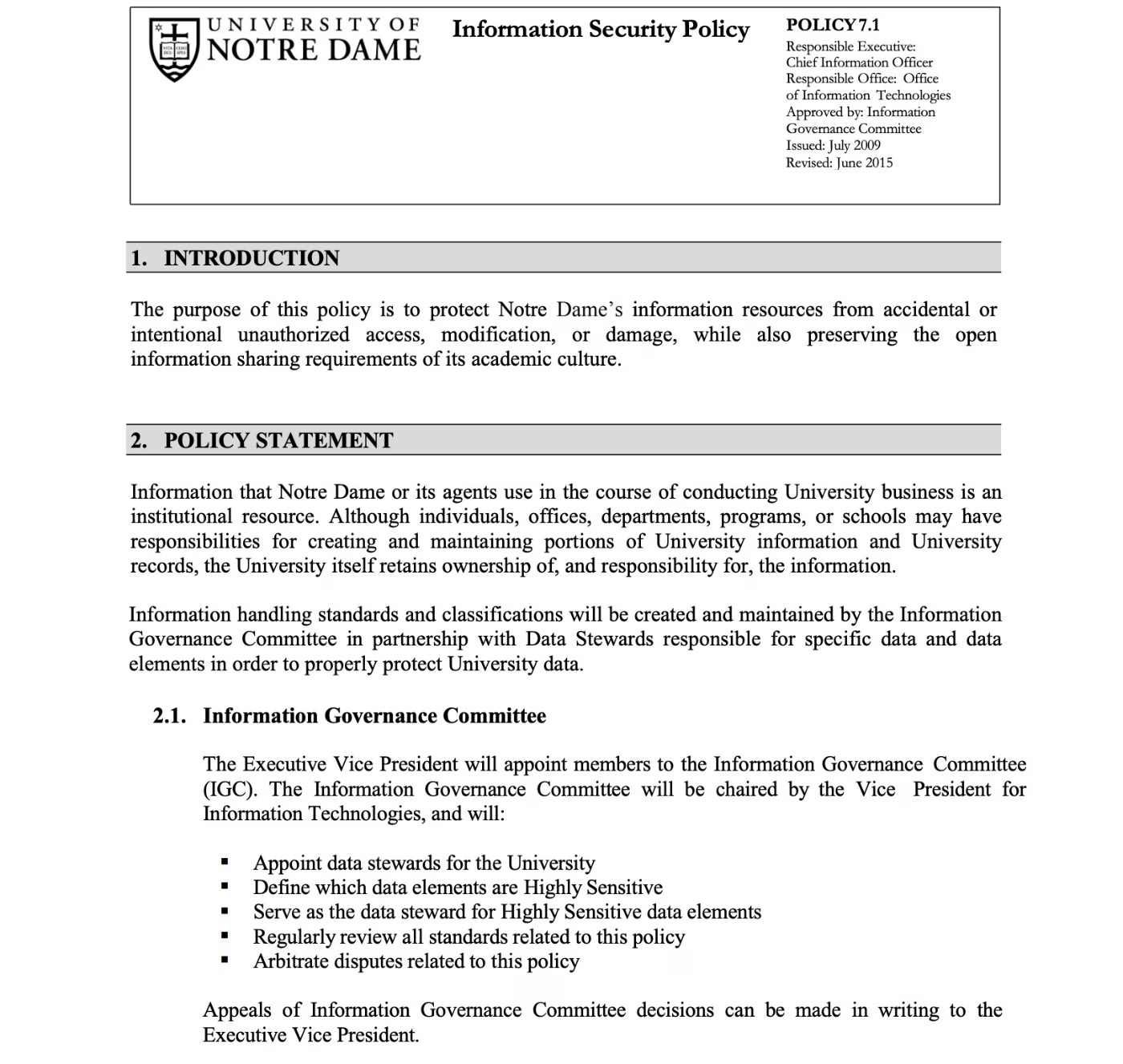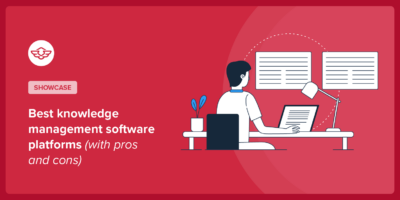Policy and Procedure Manual: Examples, Templates, and Writing Tips

Not sure how to create a policy and procedure manual, or if your business even needs one in the first place?
A policy and procedure manual is a centralized hub where employees can access key information about your business.
As your business expands, documenting these policies and procedures is essential to optimize your processes, care for your employees, protect your business, ensure compliance with government regulations, and more.
In this guide, you’re going to learn everything that you need to know about creating a policy and procedure manual. Let’s dig in…
In This Article
- What Is a Policy and Procedure Manual?
- Policy and Procedure Manual Benefits (Why You Need One)
- Types of Essential Policies and Procedures in the Workplace
- Policy and Procedure Manual Example
- Policy and Procedure Manual Template
- How to Create a Policy and Procedure Manual
- Employee Handbook vs. Policy Manual: What’s the Difference?

We rigorously test and research every product that we recommend through HeroThemes. Our review process. We may also earn a commission if you make a purchase through our links.
What Is a Policy and Procedure Manual?
A policy and procedure manual is a centralized knowledge hub where employees can access information on your business’ policies and procedures, such as how to perform certain tasks (“procedures”) and rules and regulations (“policies”).
Policies
Policies are the guiding rules and expectations. These are the “what” and “why”.
For example, a code of conduct, dress code, or an IT security policy. Policies set the principles or standards employees must follow (like “Don’t share confidential data” or “No harassment in the workplace”). They paint in broad strokes, outlining the company’s values and compliance needs.
Procedures
Procedures are the step-by-step instructions for how to carry out tasks or processes. These are the “how”, detailed steps employees should take to comply with the policies or to perform routine operations.
For example, a procedure might list how to file an expense report or the exact steps for evacuating the office in an emergency. Procedures are like the GPS directions that guide employees through specific tasks safely and consistently.
Some more examples could be details on the hiring process for managers who need to hire new employees, sick leave policy, employee benefits, and so on. We’ll share more policy and procedure manual examples in a second.
Such a centralized knowledge hub helps your employees access key information when needed, which helps your business work more effectively.
It also ensures that all of your employees are operating on the same page and fully understand the procedures and policies of your business.
Policy and Procedure Manual Benefits (Why You Need One)
Let’s go over some of the biggest benefits of creating policy and procedure manuals for your business.
1. Reduce Employee Training Time
Whenever you hire a new employee, there’s always a lag time between when they start working and when they start actually contributing to your business.
You need to help them understand key policies, how they’ll be working, what they’ll be working on, and so on.
With a policy and procedure manual, you can reduce employee training time when it comes to all of the general procedural tasks in your business.
That way, new employees can focus on training for their actual work tasks, which will help them start adding value faster.
We have a guide on how to create a training manual website, check it out!
2. Help Employees Understand Their Benefits (and Boost Retention)
Most businesses offer employee benefits to help boost retention and improve employee morale.
However, if employees don’t know how to access those benefits (or if those benefits even exist), your business won’t achieve the benefit of offering those benefits.
With a policy and procedure manual, you can clearly document all of your business’s employee benefits so that:
- Employees know what benefits exist.
- Employees know how they can access those benefits.
3. Improve Compliance With Rules and Regulations
In addition to your own business policies, your business will also likely need to comply with government rules and regulations, such as the rules around insider trading.
For some businesses, the consequences of not following these rules could be substantial in the form of fines or other penalties.
With your policy and procedure manual, you can specify what employees need to do to maintain compliance with these rules. By clearly laying out this information (and making it easy for employees to access), you can avoid unintentional mishaps and improve your compliance with those governmental rules.
For an example of this, you can see Shake Shack’s insider trading compliance policy:

4. Set Proper Expectations for Employee Conduct
If you want to avoid issues with employee conduct, it’s much easier to set expectations from the beginning than to try to adjust behavior later on.
With a policy and procedure manual, you can set proper expectations for employee conduct and culture right from the beginning to avoid issues in the future.
5. Standardize Your Business’s Processes and Protect Against Issues
Another big benefit of a policies and procedures manual is that it helps you standardize your business’s policies – as the name suggests!
By standardizing policies as much as possible, you can improve your efficiency and streamline the administrative work of your business.
You can also help protect against issues, such as using your information security policy to protect your business from a malicious actor accessing your data.
Explore:
How to Write Standard Operating Procedures (SOPs)
Process Documentation: What It Is and How to Create
6. Reduce the Burden on HR By Letting Employees Help Themselves
Your business will almost certainly have a lot of very specific policies around HR-related tasks such as payments, sick leave, vacation leave, benefits, retirement options, and so on.
If employees feel the need to reach out to your HR staff every time that they have a question, your HR staff will be bogged down by needing to answer these questions instead of working on something more valuable.
By documenting all of these important policies and procedures in your manual, you can give employees the tools that they need to find the answers themselves. That means employees can get answers whenever they need them and your HR staff can focus on other stuff.
This operates on much the same principle of how creating a customer-facing knowledge base can help you cut down on human support requests by giving customers the tools to help themselves. If you’re interested in that topic, check out our post with seven big knowledge base benefits.
Types of Essential Policies and Procedures in the Workplace
A small tech startup’s manual might look very different from that of a large hospital. But, most of workplace policy manuals cover a lot of common ground.
1. Employment and HR Policies
These policies establish the tone for workplace culture and employee rights.
This includes anti-discrimination and anti-harassment policies, which are an absolute must-have in every manual.
These policies protect both by clearly prohibiting harassment or bias, and are often legally required.
2. Compensation and Benefits
These policies cover things like payroll, overtime, holidays, and PTO (paid time off) or vacation/sick leave policies.
It should include:
- How and when people get paid
- How they can request leave
- What the company offers in terms of health insurance
- Retirement plans, and so on
3. Health and Safety Procedures
A manual should include relevant safety policies and procedures for your workplace.
For example, a construction company’s manual might include equipment operation rules and emergency site evacuation steps, while an office’s manual could include ergonomics and fire drill procedures.
Many regions have workplace safety laws, such as OSHA in the US, that essentially require these policies.
4. Information Security and Technology Use
These policies cover the following:
- Acceptable use of company computers, email, and the internet
- Password requirements
- Remote work security (VPNs and device encryption)
- Guidelines to prevent data breaches
5. Compliance and Legal Policies
Depending on your industry, there may be specific laws you must comply with.
For example, finance and publicly traded companies have policies regarding insider trading.
Healthcare organizations have extensive policies for HIPAA compliance (to protect patient privacy.
6. Operational Policies and Procedures
These policies and procedures outline how work is performed in each department. They may include standard operating procedures (SOPs) for important tasks.
Essentially, any recurring process that’s crucial to your operations should have a procedure documented.
7. Emergency and Contingency Plans
Beyond day-to-day operations, many manuals include procedures for worst-case scenarios. For example:
- Business continuity plans
- Data backup procedures
- Pandemic response policies (we all learned the importance of that!)
Keep in mind that this list doesn’t cover every type of policy and procedure, but it includes the major ones that apply to most workplaces.
Policy and Procedure Manual Example
To help you understand what a policy and procedure manual is and what types of content you should include in yours.
Let’s go over a rapid rundown of some policy and procedure manual examples that you should consider including:
- Workplace code of conduct
- Employee benefits information
- Health and safety procedures
- Emergency procedures
- Leave policy
- Vacation policy
- Remote work policy
- Organizational chart
- Business travel policies (e.g. per diem, etc.)
- HR policies
- Payment procedures
- Employee procedures for key tasks (e.g. submitting a vacation leave request)
- Job descriptions
- Promotion information (if standardized, such as different levels)
- Legal compliance rules (e.g. rules for employees investing in stock)
- Stock option information and vesting periods
- Technology usage policies
- Information security policies
- Continuing education policies
Notre Dame University’s Security Policy
For a real-life example, you can consider the Information Security Policy from Notre Dame, which helps “protect Notre Dame’s information resources from accidental or intentional unauthorized access…”

Your business might have unique policies and procedures, so this is by no means a complete list of all the content you should include in a policy and procedure manual. However, it should give you a good idea of where to start.
Policy and Procedure Manual Template
Here’s an overview of the sections typically found in a company’s policy manual. This could also serve as a template outline for you.
1. Introduction and Purpose
A brief welcome or overview stating why the manual exists.
2. Organization Profile (Mission, Vision, Values)
Include a short section about the company’s mission statement and core values.
While not exactly a policy, it reminds everyone of the bigger picture.
3. Company Policies
This can span multiple sections, and it’s the heart of the manual:
- Starts with Human Resources policies: Hiring practices, EEO statement, harassment policy, code of conduct, work hours.
- Other operational or administrative policies: Like IT usage, social media, data protection, conflicts of interest, attendance, dress code, and so on.
Each policy section should explain the rule or standard, and often who it applies to.
4. Procedures
Procedures are usually step-by-step instructions for different tasks, and many place procedures immediately after the policy they relate to.
Here are some tips:
- Use numbered steps or bullet points for clarity
- Answer the “How do I…?” questions
If a policy is “We do X,” the procedure is “Here’s how we do X, step by step.”
5. Roles and Responsibilities
Explicitly define who is responsible for what within certain procedures or policies.
6. Organizational Structure
In larger organizations, the manual may include an organizational chart or a description of the company’s structure.
While this isn’t a policy or procedure, it provides context. Employees can see how departments are structured and who reports to whom.
7. Forms and Templates
Incorporate or link standard forms and templates that employees need to use.
This will help to ensure everyone uses the same, standardized documents, which keeps things consistent.
8. Revision History
I love seeing this in manuals—a table or section showing when the manual or specific policies were last updated.
This improves transparency between employers and employees.
9. Appendices/Additional Resources
- Glossary of terms
- Copies of key regulations
- Contact information for various departments
This could be supplementary material that is too detailed for the main body, but still useful to have available.
If you’re creating your first manual, this policy and procedure template could be a good place to start.
How to Create a Policy and Procedure Manual
Now, let’s get into the actual steps for how to create a policy and procedure manual, from start to finish.
1. Plan and Organize Before You Write
Before you start writing and documenting, it’s important to have a high-level plan and structure for your manual.
This will let you know what content you need to write and how to best structure that content into a cohesive manual.
If you’re not sure where to get started, the policy and procedure manual example and template from above make a good foundation.
Your business also might have its own policies and procedures that need to be documented in your manual.
Think about how you can group them together in logical categories that will me it easier for employees to browse and navigate your manual.
With the right policy and procedure manual software, you should have no problem setting up this type of categorization.
2. Involve the Right People
Assemble a small team or at least get input from subject matter experts across the company.
Because your policies and procedures will likely span different departments, your team will need to as well.
Your main goal is to get subject matter experts for all the important policies and procedures that you need to document.
This step can also be a good spot to go back and check if you missed anything in your plan. Your team of experts might have their own feedback on new policies that should be added or changes to the structure of your manual.
3. Write in Clear, Friendly Language
Now, you’re ready to start writing. Your team should know what needs to be done and they can start creating that content based on your plan.
Some writing best practices to keep in mind:
- Use plain language: Avoid jargon, legalese, or fancy-talk.
- Keep sentences and paragraphs short
- Be specific and concrete: Vague policy statements aren’t helpful. Instead of “Submit leave requests in a timely manner,” state “Submit your PTO request at least 2 weeks before your planned vacation when possible.”
- Include examples where helpful: For a code of conduct policy, you might say “Inappropriate behavior (for example, offensive jokes, bullying, or public intoxication at company events) is prohibited.”
- Highlight critical points: If something is super important, draw attention to it.
- Make it visually clear: Use formatting to draw attention to key areas (use of headings, subheadings, lists, tables and so on). If your manual is digital, those headings become linkable (table of contents).
- Tone and voice: The tone should match your company culture somewhat.
4. Review, Revise, and Get Approvals
Once you’ve written the first drafts of your policy and procedure content, you’ll want to have that content reviewed by a separate subject matter expert.
This review process can help you catch errors and inconsistencies before you publish your content.
It’s also just generally never a bad idea to have a second set of eyeballs on content when it comes to the structure and writing quality.
Ideally, you’ll want to have a system in place so that reviewers can sign off on each piece of content before it ever gets published in your manual.
Speaking of…
5. Publish and Distribute the Manual
To make your manual easy to access, you should use policy and procedure manual software that lets your employees easily access your policies at any time.
For most businesses, you can use regular knowledge base software or documentation software, as long as it includes features to help you restrict access to your manual.
If you’re not sure where to get started, Heroic Knowledge Base offers a flexible, cost-effective way to create a policy and procedure manual.
Heroic Knowledge Base is based on the open-source WordPress software, which means that you can also benefit from all the flexibility that WordPress offers.

This combination offers several different ways to restrict access to your policy and procedure manual:
- Require users to register for accounts and log in using a username and password – this lets employees access the manual from anywhere, while still keeping things very secure.
- Create a single password that you can share with employees – this isn’t as secure because anyone with the password can access the content, but it’s very easy to set up because employees don’t need their own accounts.
- Allow access based on IP address – this can be a good option if employees work remotely but still use a company-provided VPN.
- Create an intranet site so that employees can only access content from your local network – an intranet site can be a good option if employees only need to access content while at work.
Heroic Knowledge Base is also packed with features to help you create a more effective policy manual:
- Categories – easily organize your policies and procedures into categories and let employees browse those categories.
- Live search suggestions – employees can see search results as soon as they start typing, which helps them more quickly find the right document.
- Built-in callout styles – you can use pre-defined callouts to easily add warnings and highlights to your content.
- Article feedback – employees can provide feedback on articles to help you spot issues and improve your manual. (15 Feedback Email Subject Lines That Boost Survey Clicks)
- Search analytics – you can see what employees are searching for to find weak/missing areas in your policy documentation.
- File uploads – this lets you attach PDF versions of policies or other types of files.
If you want some help getting started, we have a guide on how to set up Knowledge Base.
6. Collect Feedback
Once you’ve published your policy and procedure manual, you’re ready to share it with your employees.
If everything goes well, your job is finished…for now.
However, it’s also important to listen to employee feedback after you launch your manual.
Employees might have comments or issues that you didn’t think of. If you want to create the best manual possible, you’ll want to factor these comments into your revisions.
Speaking of revisions…
7. Keep It Up to Date
Your policy and procedure manual content is not static information that you can set and forget.
Over time, your policies and procedures might change, and those changes will need to be reflected in your manual.
Or, even if nothing changes, you might realize that a certain article isn’t as clear as you’d like it to be. In such cases, you should improve the article to make it more useful to your employees.
To help make this happen, assign articles to key stakeholders so that someone has clear responsibility. In many cases, you can assign the article to the same person who wrote it.
If you use a tool like Heroic Knowledge Base to create your manual, it can also help alert you to potential issues by letting your employees flag articles and provide feedback.
Employee Handbook vs. Policy Manual: What’s the Difference?
It’s easy to get these terms mixed up. Many people say “employee handbook” when referring to the collection of company policies. But they’re not exactly the same.
| Aspect | Employee Handbook | Policy & Procedure Manual |
|---|---|---|
| Audience & Purpose | All employees; a welcoming guide introducing the company, culture, and key policies. Ensures every employee understands expectations. | Primarily managers, HR, and power users; a reference guide for implementing and enforcing policies. |
| Tone & Style | Approachable, friendly, culture-focused, easy to read. | Formal, detailed, instructional, sometimes legalistic. |
| Length & Detail | Short and concise (≈5–30 pages); covers key policies and benefits without overwhelming. | Comprehensive (dozens to hundreds of pages); contains detailed procedures, forms, and legal compliance details. |
| Content Focus | High-level summaries: company mission/values, benefits, conduct, time-off overview, harassment policy summary, etc. | Exact “how-to” procedures: step-by-step processes, full legal policy text, investigation steps, forms, and checklists. |
| Examples | Performance Reviews: “We conduct evaluations twice a year to support growth and career development.”Disciplinary Policy: “Violation of company policies may result in disciplinary action up to and including termination.” | Performance Reviews: Detailed schedule, forms (e.g., HR-PR-2025), PIP procedures, approval steps.Disciplinary Policy: Progressive discipline stages, documentation requirements, manager scripts. |
| Distribution | Given to every employee, often signed and sometimes publicly available (e.g., company website). | Usually internal; may be managers-only or intranet-accessible for reference. |
| Primary Purpose | Onboarding and setting employee expectations in a digestible format. | Ensuring consistent policy enforcement and serving as the authoritative “playbook.” |
| Relationship | Offers the what and why of policies. | Provides the how and exact steps for policy implementation. |
Final Thoughts
That wraps up our guide to everything you need to know about creating a policies and procedures manual.
If you’re looking for the best way to publish and manage your policy and procedure manual, you can use the open-source Heroic Knowledge Base WordPress plugin.
Heroic Knowledge Base is flexible enough to adapt to any business, while still giving you access to useful features such as article feedback, real-time search suggestions, search analytics, file uploads, and lots more.
Plus, thanks to the flexibility of Heroic Knowledge Base’s WordPress foundation, you get tons of options for controlling access to your policy and procedure manual, including using an intranet, requiring user accounts, and more.
To get started, purchase Heroic Knowledge Base today.




